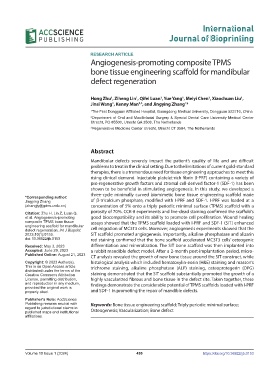Page 467 - IJB-10-1
P. 467
International
Journal of Bioprinting
RESEARCH ARTICLE
Angiogenesis-promoting composite TPMS
bone tissue engineering scaffold for mandibular
defect regeneration
Hong Zhu , Ziheng Lin , Qifei Luan , Yue Yang , Meiyi Chen , Xiaochuan Liu ,
1
1
1
1
1
1
Jinsi Wang , Kenny Man , and Jingying Zhang *
1
1
2,3
1 The First Dongguan Affiliated Hospital, Guangdong Medical University, Dongguan 523710, China
2 Department of Oral and Maxillofacial Surgery & Special Dental Care University Medical Center
Utrecht, PO 85500, Utrecht GA 3508, The Netherlands
3 Regenerative Medicine Center Utrecht, Utrecht CT 3584, The Netherlands
Abstract
Mandibular defects severely impact the patient’s quality of life and are difficult
problems to treat in the clinical setting. Due to the limitations of current gold-standard
therapies, there is a tremendous need for tissue engineering approaches to meet this
rising clinical demand. Injectable platelet-rich fibrin (I-PRF) containing a variety of
pro-regenerative growth factors and stromal cell-derived factor-1 (SDF-1) has been
shown to be beneficial in stimulating angiogenesis. In this study, we developed a
three-cycle minimally curved biomimetic bone tissue engineering scaffold made
*Corresponding author:
Jingying Zhang of β-tricalcium phosphate, modified with I-PRF and SDF-1. I-PRF was loaded at a
(zhangjy@gdmu.edu.cn) concentration of 5% onto a triply periodic minimal surface (TPMS) scaffold with a
Citation: Zhu H, Lin Z, Luan Q, porosity of 70%. CCK-8 experiments and live-dead staining confirmed the scaffold’s
et al. Angiogenesis-promoting good biocompatibility and its ability to promote cell proliferation. Wound healing
composite TPMS bone tissue assays showed that the TPMS scaffold loaded with I-PRF and SDF-1 (SIT) enhanced
engineering scaffold for mandibular
defect regeneration. Int J Bioprint. cell migration of MC3T3 cells. Moreover, angiogenesis experiments showed that the
2023;10(1):0153. SIT scaffold promoted angiogenesis. Importantly, alkaline phosphatase and alizarin
doi: 10.36922/ijb.0153 red staining confirmed that the bone scaffold accelerated MC3T3 cells’ osteogenic
Received: May 3, 2023 differentiation and mineralization. The SIT bone scaffold was then implanted into
Accepted: June 29, 2023 a rabbit mandible defect model. After a 2-month post-implantation period, micro-
Published Online: August 21, 2023 CT analysis revealed the growth of new bone tissue around the SIT construct, while
Copyright: © 2023 Author(s). histological analysis which included hematoxylin-eosin (H&E) staining and masson’s
This is an Open Access article trichrome staining, alkaline phosphatase (ALP) staining, osteoprotegerin (OPG)
distributed under the terms of the
Creative Commons Attribution staining demonstrated that the SIT scaffold substantially promoted the growth of a
License, permitting distribution, highly vascularized fibrous and bone tissue in the defect site. Taken together, these
and reproduction in any medium, findings demonstrate the considerable potential of TPMS scaffolds loaded with I-PRF
provided the original work is
properly cited. and SDF-1 in promoting the repair of mandible defects.
Publisher’s Note: AccScience
Publishing remains neutral with Keywords: Bone tissue engineering scaffold; Triply periodic minimal surface;
regard to jurisdictional claims in
published maps and institutional Osteogenesis; Vascularization; Bone defect
affiliations.
Volume 10 Issue 1 (2024) 459 https://doi.org/10.36922/ijb.0153

